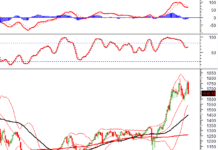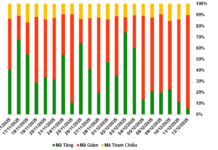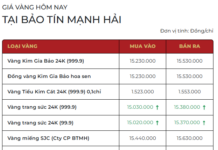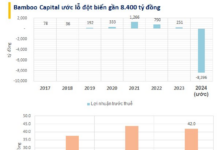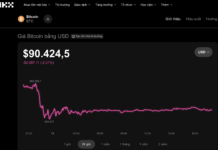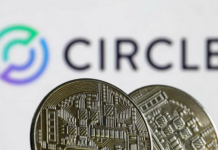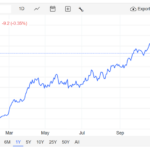
In the past month, Techcombank increased savings interest rates by 0.1 percentage points for 1-2 month terms and by 0.2 percentage points for 3-5 month terms. Photo: T.L |
Year-end liquidity pressure
The overnight interest rate in the interbank market approached the 6% threshold in mid-November 2024, doubling from a month earlier, before falling to around 4% last weekend (November 22nd). A similar trend occurred in other tenors, reflecting the system’s liquidity being under significant pressure as the year-end approaches.
Recently, the State Bank of Vietnam (SBV) had to inject net funds to support the system’s liquidity. Specifically, after net withdrawing more than VND 136,000 billion in October, with new issuances of bills resumed from October 18th, from the beginning of November to last weekend, the SBV net injected again more than VND 103,000 billion. In addition to net injection in the open market operation (OMO), a large volume of bills issued in the second half of October matured gradually while the regulator reduced new issuances from the beginning of this month.
The liquidity pressure is also reflected in the move by banks to continue raising deposit rates in the 1st market (with individuals and organizations), including unexpected hikes by major banks. In the past month, nearly 15 banks have raised deposit rates. Notably, Agribank significantly increased savings interest rates by 0.5 percentage points for terms from 1 to 11 months, surpassing the previous average of the ‘big 4’ group. Techcombank also raised savings interest rates by 0.1 percentage points for 1-2 month terms and by 0.2 percentage points for 3-5 month terms. There are also a series of other banks such as VIB, LPBank, MBBank, Bac A…
Central banks (CBs) globally are still on the path of lowering interest rates, with the latest being the US Federal Reserve (Fed) cutting rates for the second time in a row at the beginning of this November. However, this does not seem to support the interest rate trend in Vietnam much. Many forecasts suggest that deposit rates of banks and borrowing rates in the interbank market will continue to rise in the last months of the year.
|
With this year’s credit growth target set at 14-15%, credit needs to increase by at least 4% in the remaining two months of 2024, equivalent to an absolute increase of nearly VND 532,000 billion. Therefore, banks have probably started to accelerate lending activities from the beginning of this November to meet the year-end target, which partly puts pressure on deposit rates. |
If this trend persists, it will inevitably affect banks’ funding costs in the next phase. This is also likely to be an important factor influencing the profit plans set for the next year of many banks, especially small-scale banks, which not only depend largely on the domestic market channel but also frequently borrow from the interbank market to ensure short-term liquidity.
Meanwhile, larger-scale banks with certain advantages have recently strengthened the issuance of long-term securities to ensure stable and sustainable capital sources and limit the impact of rising interest rates. According to the report of the Vietnam Bond Market Association, in the first half of this November, banks issued bonds worth more than VND 6,500 billion, bringing the total issuance value from the beginning of 2024 to VND 256,400 billion, accounting for 72.1% of the total value of corporate bonds issued.
Where does the pressure come from?
The significant and widening gap between credit growth and capital mobilization of the banking system is one of the factors putting pressure on interest rates in the past time. The reported data shows that while capital mobilization as of September 27, 2024, increased by only 4.79% compared to the beginning of the year, credit increased by 8.53%, 3.74% higher. This gap was 1% and 2.95% in the first and second quarters of 2024, respectively.
According to an update at the end of October, the credit growth of the whole system reached 10%. With this year’s credit growth target set at 14-15%, credit needs to increase by at least 4% in the remaining two months of 2024, equivalent to an absolute increase of nearly VND 532,000 billion. Therefore, banks have probably started to accelerate lending activities from the beginning of this November to meet the year-end target, which partly puts pressure on deposit rates.
The second factor is the continued heat in the USD/VND exchange rate, which negatively affects VND interest rates. In the past month, banks have continuously listed the selling price of USD close to the ceiling according to SBV regulations, while the USD has strengthened in the international market. The rebound of the USD exchange rate has clearly put pressure not only on bank deposits but also on the system’s liquidity.
Specifically, in the face of the rising exchange rate, the regulator started implementing the method of spot foreign currency sales at the rate of VND 25,450/USD from October 24th, marking the first sale since July 2024. This means that a large amount of VND liquidity is absorbed through the foreign currency sales channel. With the exchange rate trend still highly unpredictable, as the year-end is also the peak import season, and the USD’s rise in the international market is supported by signals that the Fed may temporarily halt rate hikes, the pressure from the exchange rate on interest rates will continue.
Meanwhile, according to the analysis of Military Bank Securities Company (MBS), the recent increase in interbank interest rates has signaled a liquidity shortage, and the SBV’s bill issuance and the State Treasury’s withdrawal of more than $4.5 billion from three major banks in Q3 2024 are factors that have increased liquidity pressure. It is known that in the last two months, the State Treasury has also consecutively offered to buy foreign currency from banks to pay for $1 billion of international bonds due.
The third factor is that, in addition to the USD/VND exchange rate, investment channels such as the gold market, which is experiencing a strong recovery, and the soaring digital currency market can also compete with bank deposits, as Vietnam is currently one of the countries with the largest number of investors in the digital currency market. Moreover, the surge in the value of these assets also contributes to the pressure on the exchange rate.
With the conflict between Ukraine and Russia escalating again as the US recently removed barriers to the use of long-range weapons for Ukraine, and Russia approved the amended nuclear doctrine, the international gold price rebounded above the $2,700/ounce mark last week, pushing the domestic SJC gold price up by VND 5 million/tael in the buying price and VND 3.5 million/tael in the selling price, while the gold jewelry price also increased by about VND 4.5 million/tael.
At the same time, the price of the digital currency bitcoin is approaching the $100,000/BTC mark as President-elect Donald Trump announced on November 19 that he would nominate Howard Lutnick, a billionaire who believes that bitcoin should be traded like gold, as Secretary of Commerce. The value of bitcoin has more than doubled this year and risen about 40% in just two weeks after Trump’s election. During the campaign, Trump expressed support for digital assets and pledged to turn the US into the “world’s center for digital assets” and establish a national bitcoin reserve.
Trieu Minh
The Prime Minister Calls for Lower Bank Interest Rates
Prime Minister Pham Minh Chinh has urged the Governor of the State Bank of Vietnam to continue instructing commercial banks to cut costs, boost digital technology adoption, and reduce interest rates for businesses and individuals. This move aims to stimulate production and business activities in the remaining months of this year and the beginning of 2025.
The Stock Market in 2025: Forget Forex, Aim for a Breakthrough
“Unleashing the potential of the market requires a focus on public investment. By invigorating public investment, we can create a new impetus for economic growth and development, paving the way for a thriving future.”
The Fed’s Interest Rate Outlook: Gold Prices Stuck in a Tug-of-War
The global gold price remains in a state of flux during Wednesday’s trading session in the US and Thursday morning (November 28) in Asian markets. Latest economic data reveals a slowdown in the rate of declining inflation in the US, sparking concerns that the Federal Reserve will adopt a more cautious approach in their upcoming interest rate cuts.



